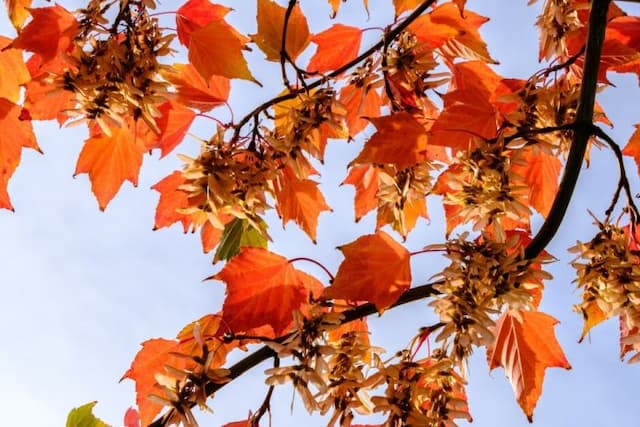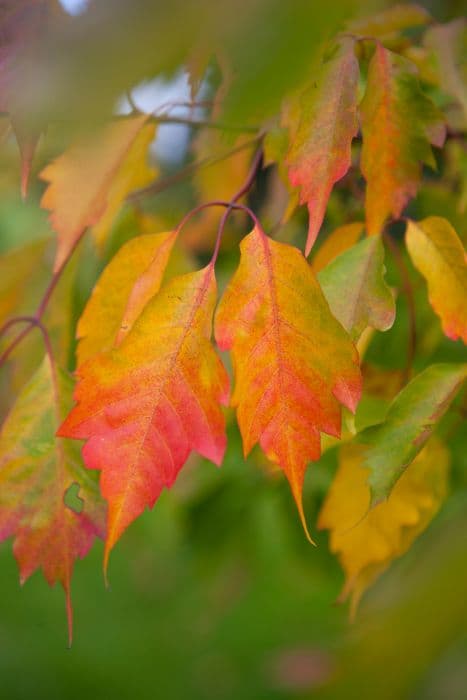White Tigress Maple Acer 'White Tigress'

ABOUT
The 'White Tigress' maple is a striking ornamental tree renowned for its unique and eye-catching features. This tree showcases leaves that are deeply lobed with pointed tips, exhibiting a classic maple leaf shape that exudes an elegant and graceful aesthetic. The foliage of 'White Tigress' maple emerges with a vibrant green hue in the spring, giving way to a kaleidoscope of colors in the fall, with shades ranging from radiant yellows to warm, fiery oranges, and sometimes even reds, offering a spectacular autumnal display. One of the most distinctive characteristics of this tree is its bark, which is especially pronounced in the winter months. The bark has an unusual patterning that resembles the stripes of a white tiger, with vertical streaks of white and pale green contrasting sharply against the darker background of the trunk and branches. The striking coloration of the bark creates a dramatic visual appeal that adds winter interest to the landscape. The branches of 'White Tigress' maple grow in an attractive, well-spaced pattern that provides the tree with a well-balanced and open canopy. This structural quality allows light to filter through, creating dappled shade beneath. The overall form of the tree can be somewhat upright, giving it a poised and stately presence in the garden. As it matures, 'White Tigress' maple develops into an eye-catching specimen with a picturesque quality, making it a popular choice for use as a feature plant in a garden or as a focal point in a landscape design. Its unique appearance and seasonal color changes ensure that it remains a center of interest throughout the year, providing beauty that evolves from season to season.
About this plant
 Names
NamesFamily
Sapindaceae
Synonyms
White Tigress Maple, White Tigress Striped Maple
Common names
Acer 'White Tigress'
 Toxicity
ToxicityTo humans
The Acer 'White Tigress' is commonly known as a type of Maple. Maples are generally considered to have a low degree of toxicity to humans, and serious poisoning is rare. However, there can be some individuals who might experience mild symptoms after ingesting parts of the plant, especially if they consume large quantities. These symptoms could include gastrointestinal discomfort, nausea, vomiting, or diarrhea. The sap of some maple species can cause contact dermatitis in sensitive persons.
To pets
The Acer 'White Tigress', as a type of Maple, is not highly toxic to most pets. However, certain types of maples, such as the Red Maple (Acer rubrum), can be harmful to horses and potentially to other animals if ingested in significant quantities. Red Maple leaves, especially when wilted or dry, can cause hemolytic anemia in horses, leading to symptoms such as lethargy, increased heart and respiratory rate, and dark brown urine. Owners should ensure their pets do not consume large amounts of any maple leaves or seeds, although toxicity in pets like dogs and cats from Acer 'White Tigress' specifically is generally low.
 Characteristics
CharacteristicsLife cycle
Perennials
Foliage type
Deciduous
Color of leaves
Variegated
Height
15-20 feet (4.5-6 m)
Spread
15-20 feet (4.5-6 m)
Plant type
Tree
Hardiness zones
5
Native area
Asia
Benefits
 General Benefits
General Benefits- Ornamental Value: Acer 'White Tigress', commonly known as White Tigress Maple, has distinctive green and white striped bark, adding year-round visual interest to landscapes.
- Shade Provider: This maple variety grows to a moderate size and can offer shade in gardens and on residential properties.
- Autumn Color: It exhibits brilliant fall colors, which can include shades of yellow and red, enhancing the autumn appeal of any garden space.
- Habitat for Wildlife: The tree can serve as a habitat and food source for birds and other wildlife.
- Adaptability: White Tigress Maple is adaptable to a variety of soil conditions, though it prefers moist, well-drained soils.
- Low Maintenance: Once established, it requires minimal care, making it suitable for both novice and experienced gardeners.
 Medical Properties
Medical PropertiesThis plant is not used for medical purposes.
 Air-purifying Qualities
Air-purifying QualitiesThis plant is not specifically known for air purifying qualities.
 Other Uses
Other Uses- Acer 'White Tigress', commonly known as the White Tigress Maple, can be used in woodworking to create visually striking furniture due to its unique striped bark pattern.
- The bark of the White Tigress Maple can be used in crafting decorative items, such as vases or candle holders, making the most of its distinctive appearance.
- The leaves of the White Tigress Maple can be pressed and used in botanical art pieces, taking advantage of their shape and color variations throughout the seasons.
- Its branches can be pruned and arranged into an attractive natural support structure for climbing plants in the garden.
- The wood from the White Tigress Maple can be fashioned into musical instruments like guitars or woodwinds, where the wood's properties can contribute to the instrument's sound quality.
- Dried seed pods from the White Tigress Maple can be used in floral arrangements or as part of a natural decorative display.
- Young saplings can be trained into living sculptures or furniture pieces, such as chairs and tables, for garden use.
- The White Tigress Maple's foliage can be used in fall season wreaths and garlands, adding a unique aesthetic with its distinct coloring.
- Photographers might use this plant as a background or feature in outdoor portrait photography due to its striking patterns and contrasting colors.
- The tree can be planted in urban environments as a part of green architecture projects to integrate natural elements into building designs and outdoor spaces.
Interesting Facts
 Feng Shui
Feng ShuiThe White Tigress Maple is not used in Feng Shui practice.
 Zodiac Sign Compitability
Zodiac Sign CompitabilityThe White Tigress Maple is not used in astrology practice.
 Plant Symbolism
Plant Symbolism- Strength: The 'White Tigress' maple, much like other maples, often symbolizes strength due to its sturdy wood and resilient nature.
- Longevity: Maples are known for their long lifespan, which can span several decades, hence representing endurance and longevity.
- Beauty: With its striking white-striped bark and decorative leaves, the 'White Tigress' maple is often associated with beauty and uniqueness.
- Protection: Maples have been historically regarded as protective symbols, likely because they provide shelter with their wide canopies.
 Water
WaterStriped Maple should be watered thoroughly, allowing the soil to be moist but not saturated. Young trees need more consistent moisture and should be watered once or twice a week, particularly during dry spells. Mature trees are more drought-tolerant but still benefit from occasional deep watering during extended dry periods. Generally, aim for about 1 to 1.5 gallons per square yard every week during the growing season, reducing frequency in the fall before the tree becomes dormant.
 Light
LightStriped Maple prefers partial shade to full sunlight. It thrives best when positioned where it receives morning sunlight and is protected from the intense heat of the afternoon sun, making it ideal for eastern or northern exposures. However, the tree is adaptable and can grow well in a range of light conditions from moderate shade to full sun, assuming it has adequate moisture.
 Temperature
TemperatureStriped Maple does well in a range of temperature conditions and is hardy in USDA zones 4 through 8. It can tolerate minimum winter temperatures down to around -30°F and is comfortable in summer temperatures up to 80°F. The ideal temperature range for this tree is between 60°F and 75°F during the growing season.
 Pruning
PruningStriped Maple should be pruned to maintain health, shape, and to remove any damaged or diseased branches. Pruning is best done in late fall or winter when the tree is dormant. Light thinning can aid in sunlight penetration and air circulation. It's important not to over-prune as this can stress the tree. Focus on removing only problematic branches and preserving the tree's natural form.
 Cleaning
CleaningAs needed
 Soil
SoilThe 'White Tigress' Maple prefers a well-drained, fertile soil with a pH of 5.5 to 7.5. A mix containing loamy garden soil, peat moss, and perlite in equal parts can support healthy growth. Make sure to amend the soil with organic matter to enhance nutrient content and water retention.
 Repotting
Repotting'White Tigress' Maple should be repotted every 2 to 3 years to prevent root binding. Young trees may require more frequent repotting, but as they mature, the frequency can decrease.
 Humidity & Misting
Humidity & Misting'White Tigress' Maple thrives in moderate humidity levels. While it can tolerate some variation, aim to maintain a humidity level around 40-60% for optimal growth.
 Suitable locations
Suitable locationsIndoor
Ensure bright light and seasonal watering for indoor 'White Tigress' Maples.
Outdoor
Plant in partial shade, protect from harsh winds for outdoor 'White Tigress' Maples.
Hardiness zone
5-8 USDA
 Life cycle
Life cycleThe 'White Tigress' Maple, a cultivar of Acer, begins as a seed that germinates in early spring. After sprouting, it enters a juvenile phase where it spends several years growing into a young tree, developing a strong root system and a sturdy trunk. As it matures, the tree enters the vegetative stage, characterized by rapid growth and the development of the distinctive white-striped bark and green foliage. Following this, it reaches the reproductive stage, where it produces flowers in the spring which, upon pollination, turn into winged seeds known as samaras that are dispersed by the wind in the fall. Over time, growth slows as the tree reaches maturity and it enters a period of maintenance, focusing on seasonal leaf production and minor thickening of the trunk and branches. Finally, after several decades, the 'White Tigress' Maple will enter the senescence phase, where it will gradually decline in health until it dies.
 Propogation
PropogationPropogation time
Late Winter-Spring
For the Acer 'White Tigress', more commonly known as the White Tigress Maple, the most popular method of propagation is by grafting, which is typically performed during the late winter or early spring when the plant is still dormant. Grafting involves taking a branch, known as a scion, from a mature White Tigress Maple with the desired characteristics and fusing it onto the rootstock of another maple variety that has a robust root system. This is done by making a sloping cut on both the scion and the rootstock, ensuring the cambium layers (the growing part of the stem) of each align properly. The two parts are then secured tightly with grafting tape or wax. This technique allows for the cloned propagation of the parent tree's characteristics, ensuring new trees have the same variegation and growth patterns as 'White Tigress'. Grafting has a higher success rate if carried out under proper temperature and moisture conditions.









